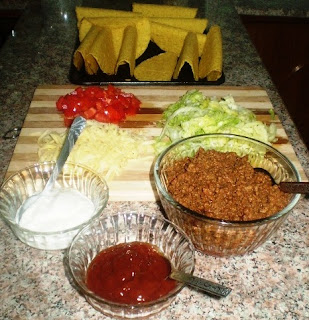
This entry is the first on an ongoing series I plan to write on how we try to cope with recurring bouts of homesickness. Though life here flows at an unhurried and peaceful pace (for which I am unceasingly grateful), we periodically go through these brief spells. Often in these cases I find that food not only brings joy and comfort, it also, if only for a brief period of time, transports one to a place deep in our hearts and minds.
I made tacos a few weeks ago, something we all once used to enjoy but rarely bothered to make at home. The origin of the taco is from Mexico, and it can be best described as the most celebrated and beloved of all Mexican street food. The best place to buy a taco in the United States is at a Taqueria, which are small restaurants that serve informal and authentic Mexican food. But no matter how tempting they were, we never ventured into them due to the fact that traditional Mexican cuisine uses a lot of pork and it’s by products. Therefore we mainly patronized local westernized chains.
A taco is simply a filled flat bread, called a tortilla. It can be made out of wheat flour or corn, the latter being more popular in the United States. It is a Spanish word and means “light snack”. In Mexico it is mainly a popular early morning or late evening treat, since the heavy meal of the day is eaten in the afternoon. It all started many years ago when farmer’s wives would bring their husbands their mid-day meals out into the fields. For practical purposes they would wrap the day’s main dish in the tortillas, thus alleviating the use of cutlery. Urbanization carried this to the cities where it has gained the status it holds today.
 Due to the large Mexican immigrant population, the taco has also gained much popularity in North America as well. In the states which border Mexico and therefore have a much larger Hispanic community, it is widely preferred over the common hamburger. It is also sometimes folded and deep fried to give it a crunchy texture, though this is mainly an American invention. Most common fillings are grilled chopped beef, ground beef or grilled chicken. Toppings include but are not limited to, shredded lettuce, grated cheese, chopped tomatoes, onions, cilantro, sliced olives, sour cream, limes wedges (to squeeze on top) and a variety of both spicy and mild sauces called salsa. Some popular types of salsas are salsa fresca (fresh salsa), salsa verde (green salsa made with tomatillo's), salsa roja (red salsa made with dried chilies) and guacamole (the popular avocado dip). Hence, one can customize their taco according to taste.
Due to the large Mexican immigrant population, the taco has also gained much popularity in North America as well. In the states which border Mexico and therefore have a much larger Hispanic community, it is widely preferred over the common hamburger. It is also sometimes folded and deep fried to give it a crunchy texture, though this is mainly an American invention. Most common fillings are grilled chopped beef, ground beef or grilled chicken. Toppings include but are not limited to, shredded lettuce, grated cheese, chopped tomatoes, onions, cilantro, sliced olives, sour cream, limes wedges (to squeeze on top) and a variety of both spicy and mild sauces called salsa. Some popular types of salsas are salsa fresca (fresh salsa), salsa verde (green salsa made with tomatillo's), salsa roja (red salsa made with dried chilies) and guacamole (the popular avocado dip). Hence, one can customize their taco according to taste. 
So the old proverb and cliché is true; “You can take the boy out of the country, but you can’t take the country out of the boy”. And so we all await patiently for the arrival of summer, when we can go back for an all too brief visit to the country…
The following is a recipe for salsa fresca (fresh sauce), also known as salsa cruda (raw sauce) or pico de gallo (rooster's beak).
Salsa Fresca
Ingredients:
2 large tomatoes, finely diced
1 large onion, finely diced
2 tablespoons finely chopped cilantro
1 small green chili, seeded and finely diced (hotness of chili can be decided according to taste)
Juice of 1 lime
¼ teaspoon salt
Directions:
Mix all ingredients in a bowl. Can be used as an accompaniment for a variety of meat & seafood. Enjoy!


No comments:
Post a Comment